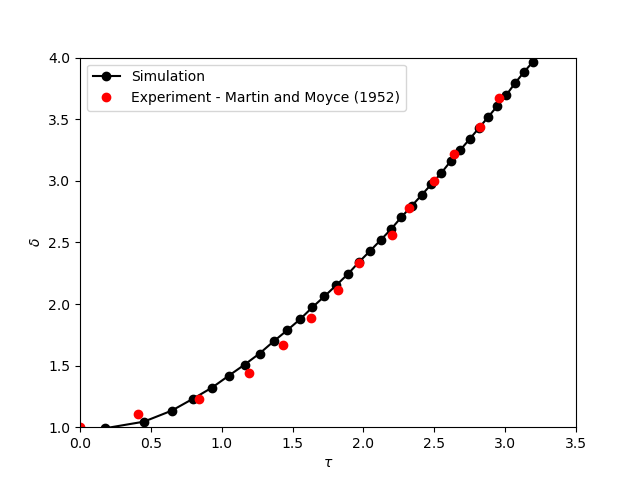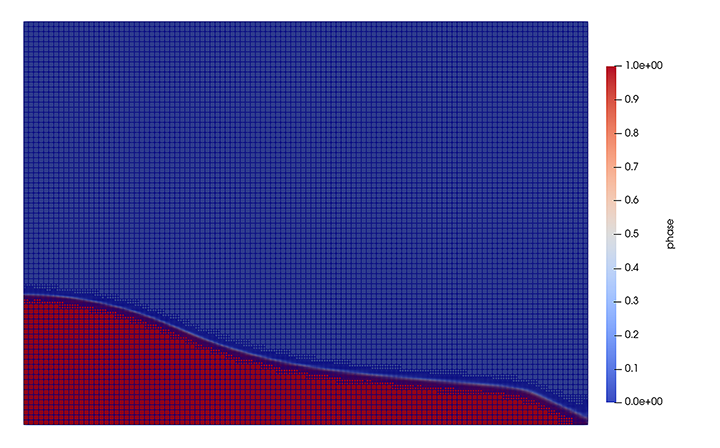Dam-Break#
This example simulates the dam break experiments of Martin and Moyce [1].
Features#
Solver:
lethe-fluid(with Q1-Q1)Two phase flow handled by the Volume of fluids (VOF) approach with projection-based interface sharpening
Unsteady problem handled by an adaptive BDF1 time-stepping scheme
The use of a python script for post-processing data
Files Used in This Example#
Both files mentioned below are located in the example’s folder (examples/multiphysics/dam-break).
Parameter file:
dam-break-Martin-and-Moyce.prmPostprocessing Python script:
dam-break-2d.py
Description of the Case#
A liquid is fixed behind a dam at the left most corner of a rectangular domain as shown in the figure below. At \(t = 0\) s, the dam is removed, and the liquid is released into the total simulation domain.
The following schematic describes the geometry and dimensions of the simulation in the \((x,y)\) plane:
Note
All the four boundary conditions are slip, and an external
gravity field of \(-1\) is applied in the \(y\) direction.
Parameter File#
Simulation Control#
Time integration is handled by a 1st order backward differentiation scheme (bdf1), for a \(4.1\) s simulation time with an initial time-step of \(0.01\) seconds.
Note
This example uses an adaptive time-stepping method, where the time-steps are modified during the simulation to keep the maximum value of the CFL condition below a given threshold.
subsection simulation control
set method = bdf1
set time end = 4
set time step = 0.01
set adapt = true
set max cfl = 0.5
set output name = dam-break
set output frequency = 20
set output path = ./output/
end
Multiphysics#
The multiphysics subsection enables to turn on (true)
and off (false) the physics of interest. Here VOF is chosen.
subsection multiphysics
set VOF = true
end
VOF#
To prevent the interface between phases from becoming blurry due to diffusion, the interface projection-based interface sharpening method is selected in the interface regularization method subsection. Furthermore, the phase filtration is enabled in this example. We refer the reader to the The Volume of Fluid (VOF) Method documentation for more explanation on both methods.
subsection VOF
subsection interface regularization method
set type = projection-based interface sharpening
set frequency = 20
subsection projection-based interface sharpening
set threshold = 0.5
set interface sharpness = 1.5
end
end
subsection phase filtration
set type = tanh
set beta = 10
end
end
Initial Conditions#
In the initial conditions, the initial velocity and initial position
of the liquid phase are defined. The liquid phase is initially
defined as rectangle of length \(= 3.5\) and height \(= 7\).
subsection initial conditions
set type = nodal
subsection uvwp
set Function expression = 0; 0; 0
end
subsection VOF
set Function expression = if (x<3.5 & y<7 , 1, 0)
end
end
Source Term#
The source term subsection defines the gravitational acceleration:
subsection source term
subsection fluid dynamics
set Function expression = 0;-1.0; 0
end
end
Physical Properties#
Two fluids are present in this simulation, hence in the physical
properties subsection, their physical properties should be defined:
subsection physical properties
set number of fluids = 2
subsection fluid 0
set density = 1.2
set kinematic viscosity = 0.01516
end
subsection fluid 1
set density = 1000
set kinematic viscosity = 0.000001
end
end
We define two fluids here simply by setting the number of fluids to be \(2\).
In subsection fluid 0, we set the density and the kinematic viscosity for the phase associated with a VOF indicator of 0.
Similar procedure is done for the phase associated with a VOF indicator of 1 in subsection fluid 1.
Mesh#
We start off with a rectangular mesh that spans the domain defined by the corner points situated at the origin and at point
\([14,10]\). The first \(14,10\) couple defines the number of initial grid subdivisions along the length and height of the rectangle.
This makes our initial mesh composed of perfect squares. We proceed then to redefine the mesh globally three times by setting
set initial refinement=3.
subsection mesh
set type = dealii
set grid type = subdivided_hyper_rectangle
set grid arguments = 14, 10 : 0, 0 : 14, 10 : true
set initial refinement = 3
end
In the mesh adaptation subsection, adaptive mesh refinement is
defined for phase. min refinement level and max refinement
level are 3 and 5, respectively. The adaptation strategy fraction type is set to fraction, which leads
the mesh adaptation to refine the cells contributing to a certain fraction of the total error. This is highly
appropriate for VOF simulations since the error for the VOF field is highly localized to the
vicinity of the interface. We set initial refinement steps=4 to ensure that the initial mesh
is adapted to the initial condition for the phase.
subsection mesh adaptation
set type = kelly
set variable = phase
set fraction type = fraction
set max refinement level = 5
set min refinement level = 3
set frequency = 1
set fraction refinement = 0.99
set fraction coarsening = 0.01
set initial refinement steps = 4
end
Running the Simulation#
Call lethe-fluid by invoking:
to run the simulation using six CPU cores. Feel free to use more.
Warning
The code will compute \(35,000+\) dofs for \(600+\) time iterations. Make sure to compile Lethe in Release mode and run in parallel using mpirun. This simulation takes \(\sim \, 3\) minutes on \(6\) processes.
Results and Discussion#
The following image shows the screenshots of the simulation at \(0\), \(1\), \(2\), \(3\), and \(4\) seconds, of the phase results without and with phase filtering. The red area corresponds to the liquid phase and the blue area corresponds to the air phase.

A python postprocessing code (dam-break-2d.py) is added to the example folder to postprocess the results. Run
to execute this postprocessing code, where ./output is the directory that contains the simulation results.
In postprocessing, the maximum dimensionless lateral position of the liquid phase is tracked
through time and compared with the experiments of Martin and Moyce (1952) [1].
The following figure shows the result of the postprocessing, with a good agreement between the simulation and the experiment:

As mentioned previously, this simulation uses adaptive mesh refinement. The following image shows the mesh and the position of the interface at \(4\) s. The mesh refinement detects and refines the meshes on the interface.
